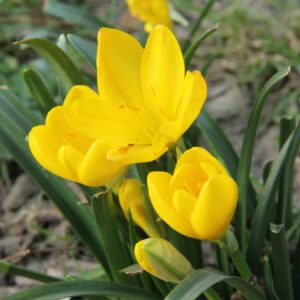 What features are essential to a successful garden? Some people would say “structure”. Others would opine that no garden is complete without some kind of water feature—even if that water feature is only a birdbath. Still others would say “evergreens” or “hardscaping” or “four seasons of interest”. All of those things contribute to the best gardens, but I think one more element is needed—surprise. Every interesting garden that I have ever seen features surprises for the visitor. It could be piece of garden décor that suddenly pops into view when you round a corner. It might be a mirror positioned on a back wall that makes the garden look bigger. Maybe it is a wacky element in an otherwise formal landscape. The possibilities for surprise are endless, and many do not require expensive installations—just creative ideas.
What features are essential to a successful garden? Some people would say “structure”. Others would opine that no garden is complete without some kind of water feature—even if that water feature is only a birdbath. Still others would say “evergreens” or “hardscaping” or “four seasons of interest”. All of those things contribute to the best gardens, but I think one more element is needed—surprise. Every interesting garden that I have ever seen features surprises for the visitor. It could be piece of garden décor that suddenly pops into view when you round a corner. It might be a mirror positioned on a back wall that makes the garden look bigger. Maybe it is a wacky element in an otherwise formal landscape. The possibilities for surprise are endless, and many do not require expensive installations—just creative ideas.
I had my own garden surprise last week on a trip to Virginia. Walking along a street in a little northern Virginia town I caught sight of what at first appeared to be a group of yellow species tulips growing in an embankment that bounded a home garden. September is the time for asters and goldenrod, not tulips, so my curiosity was piqued.
A closer inspection revealed that the “tulips” wore more like large butter-yellow crocuses, with upright “cups” on relatively short stems. A vague memory stirred in my mind and the word “Sternbergia” emerged. I double-checked with a well-known plant identification device—my cell phone—and the identification was confirmed. The “tulip’ was Sternbergia lutea, also sometimes known as “autumn daffodil”, “winter daffodil”, “lily-of-the-field” or “yellow autumn crocus”. Of all of those common names, the daffodil descriptors are closest to reality. Sternbergia is a member of the amaryllis or Amaryllidaceae family, related to spring-flowering daffodils, as well as diminutive snowdrops and gigantic holiday hippeastrum, more commonly known as amaryllis.
The Latin name “lutea” means yellow, and Sternbergia lutea is the most widely available species in the genus. Sprouting from a bulb, the elongated, somewhat grass-like leaves arise from the base of each plant at about the same time as the flowers. Individual flower stems are about six inches tall. The blossoms, which are cup or goblet-shaped in bud, flare out into yellow stars when the six petals are fully open. The leaves are ephemeral, disappearing in late fall or winter, long after flowering. Happy plants, grown in full sun or very light shade, can and do naturalize, which I suspect is what happened on that Virginia embankment.
And when the plants are happy, so are the fall pollinators that find it easy to light on the open flowers. As with other members of the amaryllis clan, Sternbergia are infrequently browsed by deer, allowing them the time and opportunity to bloom, flourish and form nice clumps.
Of course, gardening life is full of complications. I had a strong urge to rush to the computer and order some Sternbergia for my own garden. The bulbs were available from several vendors, but growing advice came with a caveat—“sharp soil drainage is important, particularly in the winter months.” My soil is heavy clay, which euphemists would call “moisture retentive” and pessimists would call “difficult to work with.” I call the situation challenging, and as I clicked on the “place order now” tab, I vowed to include some sand or grit in the planting holes to give my new Sternbergias the good drainage they deserve.
Sternbergia was named after one of history’s many botanizing clergymen, Kaspar Maria von Sternberg, a Bohemian aristocrat of the late eighteenth and early nineteenth centuries. Much better known for things scientific than ecclesiastical, Sternberg established both a museum and a botanical garden, and conducted pioneering research in the field that become known as paleobotany.
Sternbergia, like many plants, packs a large load of historical context into a small, flowery package. The context is interesting, but the package is compelling. If you would like to create a bit of autumn surprise in your garden, go to Brent and Becky’s Bulbs, 7900 Daffodil Lane, Gloucester, VA 23061; Tel. (877) 661-2852; www.brentandbeckysbulbs.com.
